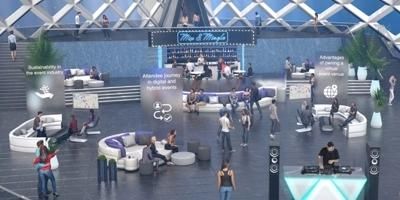
Virtual Reality in Film: Visionary Fiction or More?

Patrizia Amaliah Ciuta / June 2019 / Science Fiction
“In virtual reality, it’s more about capturing and creating worlds that people are inhabiting. You really are a creator in the way the audience lives within the world that you are building” – Chris Milk, music video director and VR entrepreneur, is absolutely right with his statement. The appeal of virtual realities lies above all in their function as a creative medium. This technology is designed like a construction kit for immersive environments which can be individually adapted to the vision of the respective creators.
Although the term Virtual Reality is familiar to many, only a few people outside of the tech industry truly understand what it is all about and which features actually exist. In everyday life, people generally connect VR with the gaming industry and science fiction, as its other uses are less well-known. VR-optimized video games for Oculus Rift and PlayStation VR and digital interfaces which can be explored using headsets like HTC Vive and Google Daydream have been around for years and are becoming increasingly popular – not only in the private sector, but also in science.
With the current state of technology, the limits of VR are very obvious. Although there are VR experiences which feel real enough to cause dizziness, amazement and fascination, users always remain aware of their physical environment to a certain extent – and this is an immersion-breaking issue. Currently, a complete immersion of all senses can only be achieved in science fiction. How exactly VR works in fiction and which application areas there are for it, are issues which do not follow any fixed rules other than the current technological possibilities. Similar to the shifting logic of time travel in Back to the Future (1985) when compared to Looper (2012) or the Harry Potter series (and countless other examples), the way in which virtual realities work and what they are used for changes every time.
These unlimited possibilities are reflected within the numerous representations of VR in film – the various virtual landscapes are very different and range from hyper-futuristic metropolises to stylized dream landscapes. Another large difference lies in the transition of characters from their reality into a virtual world – the creative minds of the film industry let their imagination run wild and keep coming up with interesting options for achieving this journey from one world into another. The following list compiles a few of the most memorable depictions of VR in film.
1. The Matrix: The pioneer of the genre
Inspired by the aesthetics of Japanese animations such as Akira (1988) and Ghost in the Shell (1995), which are considered classics within the genre of science fiction anime, and combined with elements from the goth and cyberpunk subcultures, The Matrix (1999) is an overwhelming experience. The peculiarity here is that the protagonist is already living within the simulation at the beginning of the film without being aware of it. The “real world” only becomes part of the plot after Neo is enlightened by Morpheus and frees himself from this illusion by choosing the “Red Pill” – this choice has meanwhile become a metaphor for seeking the truth. After this turning point, Neo and his comrades-in-arms enter the “Matrix” simulation only to undermine and hack it. They upload their consciousness into the matrix through a device which taps into their spinal cord and thus their brain waves. But beware: if you die in the Matrix, you die in reality!
2. The Cell: VR as a door to the subconscious
Tarsem’s films, always make it easy to recognize his origins as a designer and director of video clips thanks to the refined aesthetics which are part of his artistic style. The Cell (2000) is part of a subgenre which uses virtual realities to penetrate a character’s subconscious – Vanilla Sky (2001) and even Inception (2010) are similar in that respect. The VR technology used in this film clearly stands out from other versions: the characters cover their faces with a high-tech mesh which allows VR access and wear suits (reminiscent of the armor from Bram Stoker’s Dracula) with sensors that are attached to suspension hooks to avoid the effects of external influences. In this case, VR is used as a kind of psychotherapy and entryway into exploring the subconscious mind of a killer.
3. Tron: Only one way out of the simulation
This story takes place in a virtual world that differentiates between the artificial intelligence of the programs populating the virtual “grid” and the dominant power of the “users” who created this environment. The journey into this grid which is dominated by neon lights and minimalist futurism, is facilitated by a laser transmission of the protagonists in the original Tron (1982), and the sequel Tron: Legacy (2010), both. Similar to The Matrix, VR holds dangers for the users who enter this world, too. The fact that only users can activate the laser portal, not only leads to an uprising of the sentient AI, but also culminates in a race against time to leave the grid, as the exit only remains active for a limited time. Subsequently, the viewer learns that this type of VR can become a prison.
4. Ready Player One: Taking gaming to the next level
With many references to well-known video games (and product placement of popular titles), Spielberg’s latest film is a tribute to the gaming aspect of VR. In this film, the world has turned into a slum by 2045. For this reason the multiplayer VR game “OASIS” has become a popular means of distraction for the general population. There are no limits to the players’ imagination and they can be whoever they want – it is a “digital oasis” which becomes a virtual escape from the depressing reality. The protagonist enters OASIS using a sensor suit and a headset, and purchases DLC (downloadable content) such as clothing, weapons and artifacts with real money in order to enhance his in-game skills. While this version of VR is more futuristic and far-reaching than anything which can be achieved today, the technology depicted in Ready Player One lies well within the realm of possibilities.
5. San Junipero: A (virtual) afterlife
A question as old as mankind itself: Is there a life after death? Therefore, it is no surprise that the more philosophical works of VR science fiction also ask this question. In the award-winning Black Mirror episode San Junipero (2016), the protagonists have the opportunity to explore a virtual world on a trial basis and then decide whether they want to make their stay permanent. Thus VR becomes a kind of afterlife in which old people can be young again, sick people can be healthy again, and even comatose patients get a second chance to free their consciousness from the defective cage of their body. If one decides to stay, it means a decision to detach one’s consciousness from the limitations of their physical body. The consciousness is transferred to a data medium and becomes a part of the San Junipero cloud where inhabitants can enjoy their dream life together with other human consciousnesses within the cloud.
As you can see, there are many different ways in which virtual realities are taken up and interpreted by science fiction. Sometimes these interpretations are closer to the edge of the imaginable, while in other scenarios they can be more abstract and the technological foundations more difficult to grasp. For us as employees of a tech company which primarily offers digital events and virtual trade fairs, virtual realities are a riveting topic. Of course, the actual application of VR and similar technologies does not focus on the science fiction aspect and fortunately VR bears no actual fatal risks and side effects.
Although VR glasses are not part of the picture yet, we have the possibility to design virtual landscapes and trade fair interfaces for customers who want to provide an immersive experience to their guests and event participants. Our clients can let their creativity take over, as our technology makes it possible to build realistic surfaces with 3D models or to design more abstract representations for digital events. And who knows, maybe people will be able to take part in virtual events with the right VR equipment or via laser transmission in the future – all from the comfort of their own home while they experience the event from a first-person perspective…
